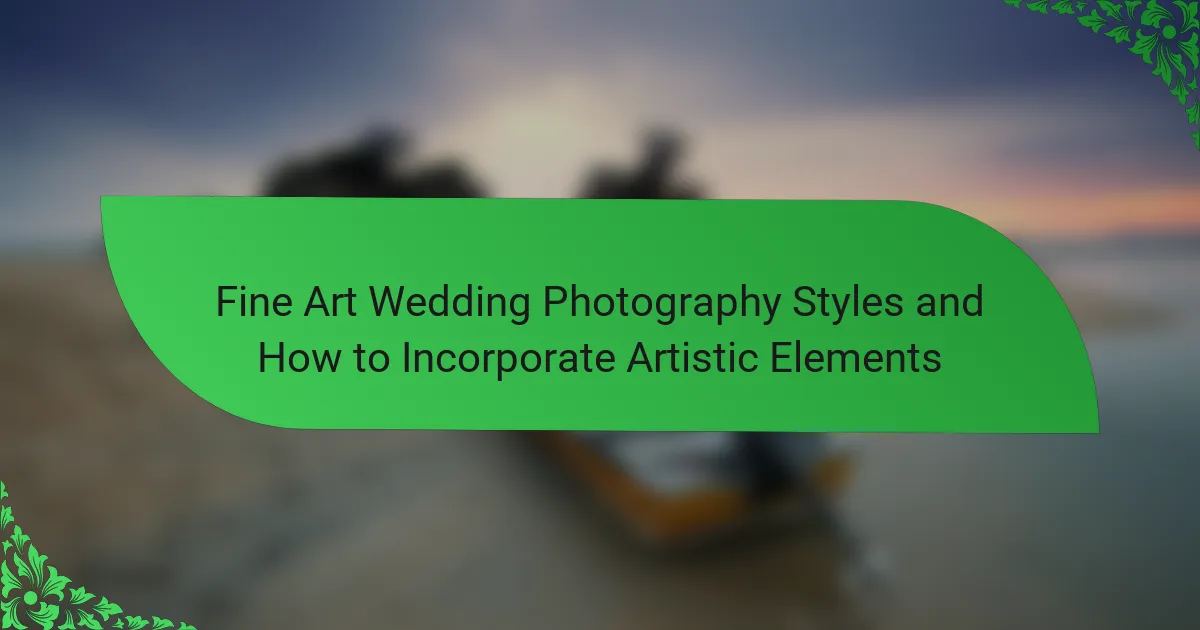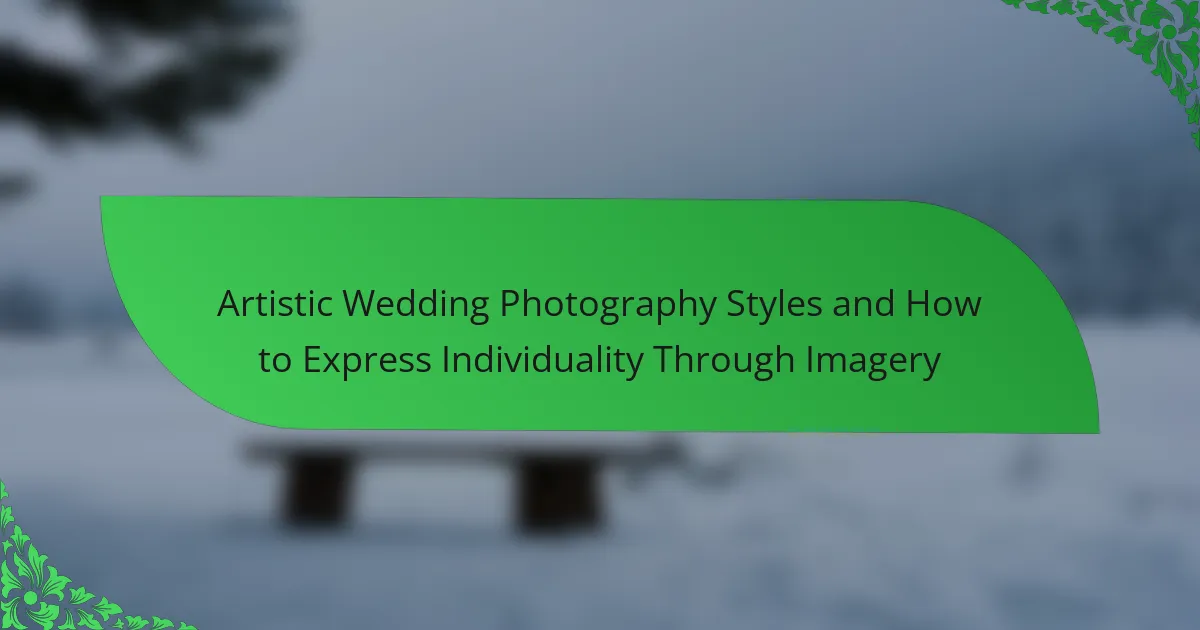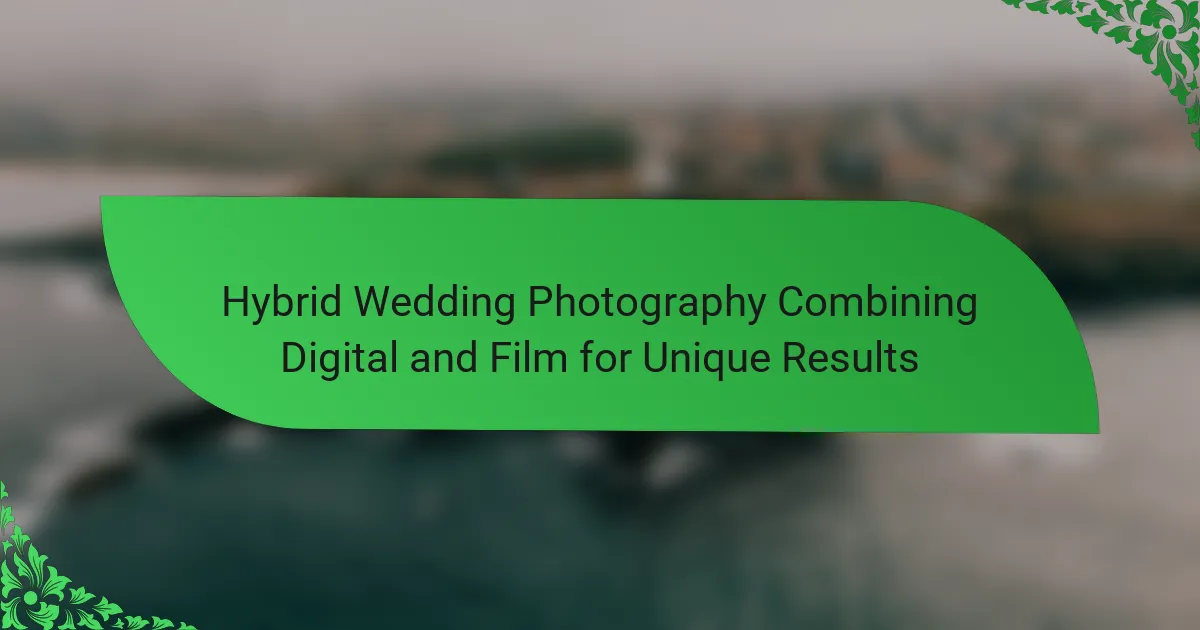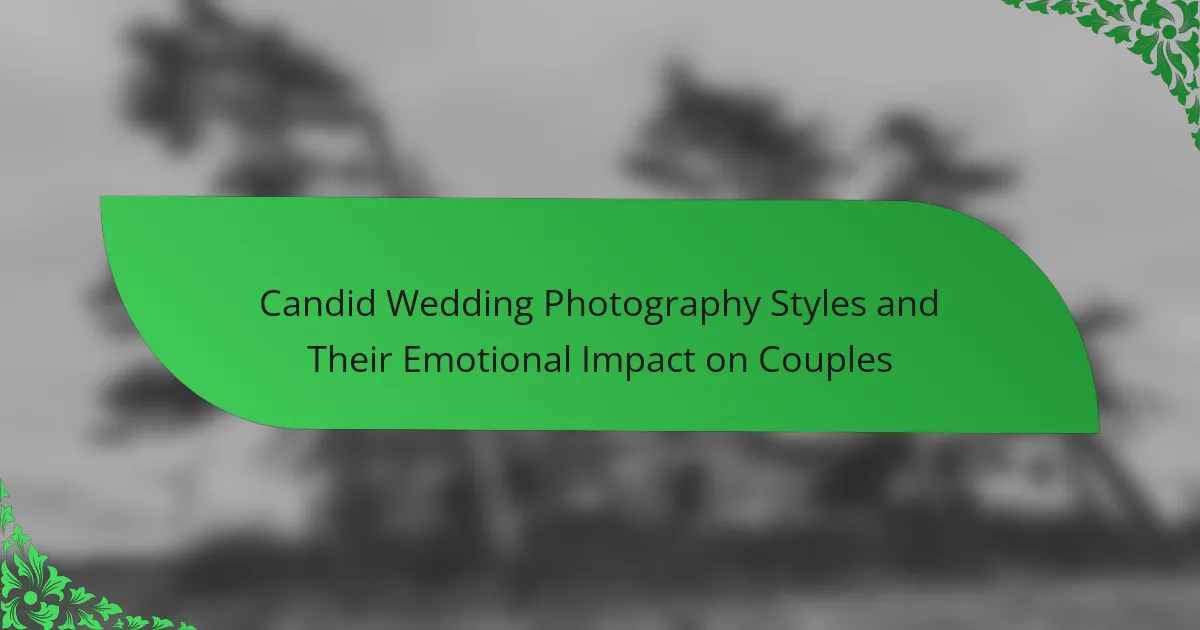Fine art wedding photography encompasses various styles that prioritize artistic expression and aesthetic quality, including documentary, portraiture, and artistic approaches. The documentary style captures candid moments and emotions, while portraiture focuses on posed images that reflect the couple’s personalities. Artistic elements are integrated through techniques such as unique angles, natural light, and complementary color palettes, enhancing the overall visual narrative. This article explores the distinct characteristics of each fine art photography style and provides insights on how to incorporate these artistic elements to create timeless wedding images that tell a unique story.
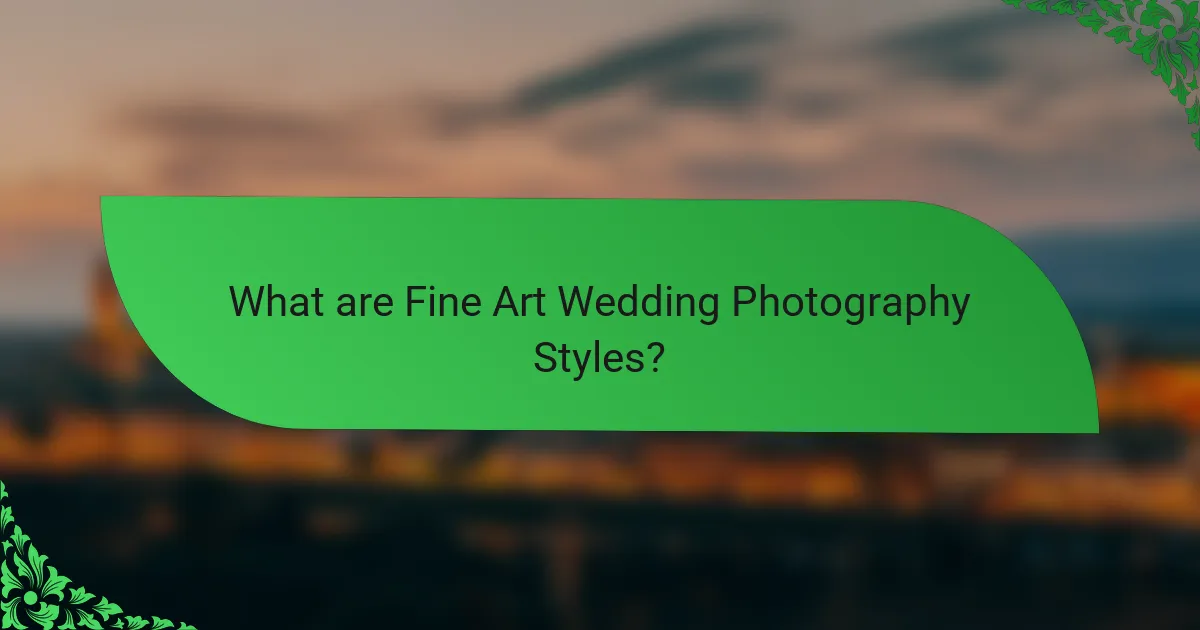
What are Fine Art Wedding Photography Styles?
Fine art wedding photography styles emphasize artistic expression and aesthetic quality. These styles often include documentary, portraiture, and editorial approaches. Documentary style captures candid moments and emotions throughout the day. Portraiture focuses on posed images that highlight the couple’s personalities. Editorial style resembles fashion photography, often incorporating dramatic lighting and styling. Each style aims to create timeless images that reflect the couple’s unique story. Fine art photography is characterized by its attention to detail and composition. This approach elevates wedding photography to an art form, making it distinct from traditional styles.
How do Fine Art Wedding Photography Styles differ from traditional styles?
Fine Art Wedding Photography styles differ from traditional styles in their artistic approach. Fine Art emphasizes creative composition and storytelling. It often utilizes natural light and unique angles. Traditional styles focus on posed shots and standard framing. Fine Art photographers aim to capture emotions and moments candidly. Their work often resembles fine art paintings. Traditional photography prioritizes documentation over artistic expression. This distinction highlights the subjective nature of Fine Art.
What are the key characteristics of Fine Art Wedding Photography?
Fine Art Wedding Photography is characterized by its artistic approach and attention to detail. It emphasizes composition, lighting, and emotion. Photographers often use natural light to create soft, romantic images. The style includes posed and candid shots that tell a story. Fine Art Wedding Photography often features unique angles and perspectives. It prioritizes aesthetics and visual storytelling over traditional documentation. This approach results in timeless, elegant images that evoke feelings. The use of film or high-quality digital cameras enhances the overall quality of the photographs.
How do lighting and composition play a role in Fine Art styles?
Lighting and composition are fundamental elements in Fine Art styles. They significantly influence the mood, focus, and storytelling of an artwork. Effective lighting can create depth and highlight specific features. It can evoke emotions by altering the atmosphere of the scene. Composition guides the viewer’s eye and organizes visual elements harmoniously. Techniques like the rule of thirds enhance balance and interest. Historical examples show that artists like Rembrandt used chiaroscuro to create dramatic effects. These principles remain relevant in contemporary Fine Art, including wedding photography. Proper application of lighting and composition results in visually compelling and emotionally resonant images.
Why is Fine Art Wedding Photography popular among couples?
Fine Art Wedding Photography is popular among couples due to its artistic and timeless approach. This style emphasizes creativity, composition, and emotional storytelling. Couples appreciate the unique aesthetic that fine art photography provides. It often captures candid moments in a beautifully composed manner. The use of natural light enhances the romantic feel of the images. Many couples desire a personalized and artistic representation of their wedding day. Fine art photographers often spend more time planning and staging shots. This results in images that resemble works of art rather than standard wedding photos. The popularity is also reflected in social media trends, where couples share their artistic wedding images widely.
What emotional impact does Fine Art Wedding Photography have on viewers?
Fine Art Wedding Photography evokes strong emotional responses in viewers. This style captures genuine moments with artistic composition. The use of natural light and unique angles enhances the emotional depth of the images. Viewers often feel nostalgia and joy when looking at these photographs. The storytelling aspect resonates deeply, allowing viewers to connect with the emotions of the couple. Studies show that visual storytelling can trigger empathy and emotional engagement. Fine Art Wedding Photography creates lasting impressions, making viewers feel part of the couple’s journey. Overall, it fosters a sense of beauty and romance that transcends the mere documentation of an event.
How does Fine Art Wedding Photography enhance the storytelling aspect of weddings?
Fine Art Wedding Photography enhances the storytelling aspect of weddings by capturing emotions and moments in an artistic manner. This style prioritizes aesthetics and composition, creating visually compelling narratives. Photographers often use natural light and unique angles to evoke feelings. The focus on candid moments adds authenticity to the story. Additionally, Fine Art Photography often includes detailed shots of decor and surroundings, enriching the overall narrative. By emphasizing the couple’s connection, it creates a personal story. The result is a collection of images that narrate the wedding day beautifully and meaningfully.
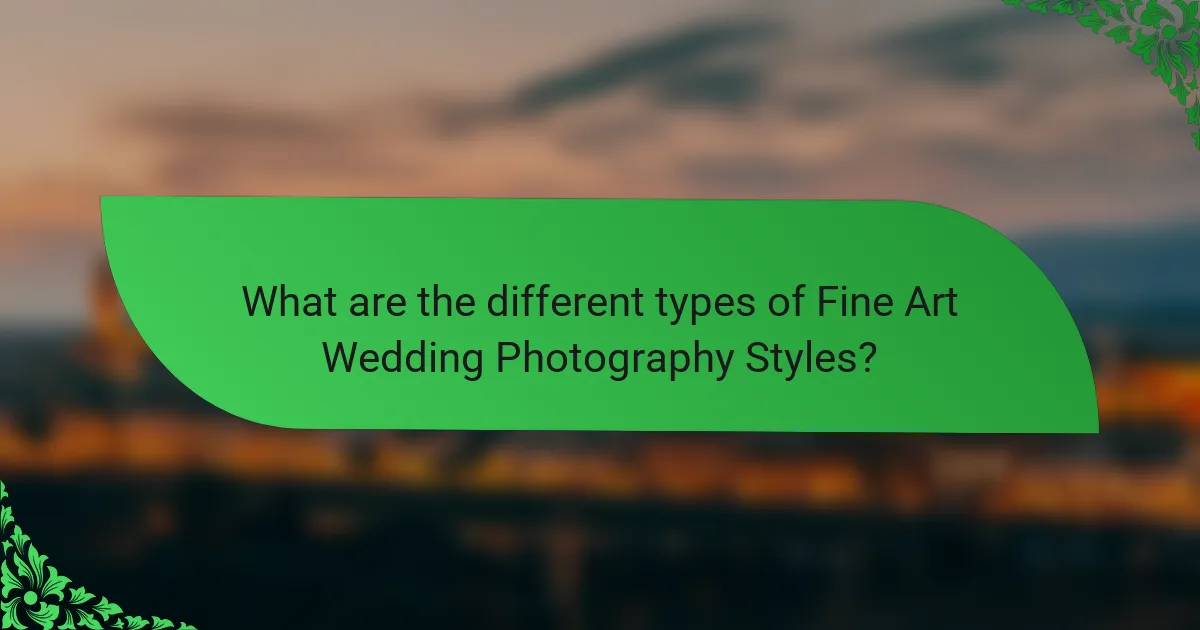
What are the different types of Fine Art Wedding Photography Styles?
The different types of Fine Art Wedding Photography styles include documentary, portraiture, and artistic. Documentary style captures candid moments throughout the wedding day. This approach emphasizes storytelling through natural interactions. Portraiture focuses on posed images that highlight the couple’s emotions and connections. Artistic style incorporates creative elements, such as unique angles and lighting techniques. Each style aims to create timeless images that reflect the couple’s personality. Fine art wedding photography often combines these styles for a diverse portfolio. This versatility allows photographers to cater to different client preferences.
How can couples choose the right Fine Art style for their wedding?
Couples can choose the right Fine Art style for their wedding by identifying their personal aesthetic preferences. They should explore different Fine Art photography styles, such as ethereal, documentary, or romantic. Evaluating portfolios of various photographers helps couples visualize how these styles can be applied. Couples should also consider the mood and theme of their wedding when selecting a style. Discussing their vision with potential photographers can provide insights into how their ideas can be captured. Additionally, reviewing testimonials and previous work can help in making an informed decision. Ultimately, the chosen Fine Art style should resonate with the couple’s unique love story and wedding atmosphere.
What factors should be considered when selecting a Fine Art style?
When selecting a Fine Art style, consider the emotional impact, aesthetic preferences, and intended message. Emotional impact influences how viewers connect with the artwork. Aesthetic preferences dictate the visual elements that resonate with the artist or audience. The intended message shapes the narrative conveyed through the art. Additionally, the medium used can affect the style’s overall execution. Historical context can also inform the choice of style, as certain movements evoke specific cultural significance. Finally, the target audience should be considered, as different styles appeal to various demographics.
How do personal preferences influence the choice of Fine Art style?
Personal preferences significantly influence the choice of Fine Art style. Individuals often select styles that resonate with their emotions and aesthetic values. For example, someone who appreciates minimalism may prefer a clean, modern Fine Art style. Conversely, a person drawn to vibrant colors might opt for a more expressive, abstract approach. Cultural background also plays a role in these preferences. Historical influences and personal experiences shape what styles individuals find appealing. Trends in society can further affect choices, as people often gravitate towards popular aesthetics. Ultimately, personal preferences create a unique lens through which Fine Art styles are chosen.
What unique attributes define various Fine Art Wedding Photography styles?
Fine Art Wedding Photography styles are defined by unique attributes such as composition, lighting, and emotional storytelling. Each style emphasizes artistic expression and aesthetics. For instance, the documentary style captures candid moments, focusing on authenticity. The editorial style resembles fashion photography, prioritizing posed shots with dramatic lighting. The romantic style highlights soft, dreamy aesthetics, often using pastel colors. The vintage style incorporates nostalgic elements, using film-like textures and muted tones. Each of these styles has distinct characteristics that influence the overall visual narrative of wedding photography.
What are the distinctive features of Romantic Fine Art Photography?
Romantic Fine Art Photography is characterized by its emphasis on emotion and intimacy. This style often utilizes soft lighting to create a dreamy atmosphere. It frequently incorporates natural elements, such as flowers and landscapes, to enhance the romantic feel. Composition plays a crucial role, with a focus on candid moments and genuine expressions. Color palettes tend to be muted and pastel, contributing to a serene aesthetic. Textures, such as lace and silk, are often included to add depth. The use of vintage props can evoke nostalgia and charm. Overall, this style aims to tell a love story through visual artistry.
How does Vintage Fine Art Photography differ from Modern styles?
Vintage Fine Art Photography emphasizes nostalgia and timeless aesthetics, while Modern styles focus on contemporary themes and techniques. Vintage photography often utilizes film, soft focus, and muted colors to evoke a sense of history. In contrast, Modern styles frequently employ digital technology, vibrant colors, and sharp clarity. Vintage compositions may feature classic poses and settings, aiming for romanticism. Modern photography often embraces spontaneity and candid moments, showcasing current trends. Additionally, Vintage works may incorporate elements from past artistic movements, like Impressionism. Modern photography tends to reflect current societal themes and cultural narratives.
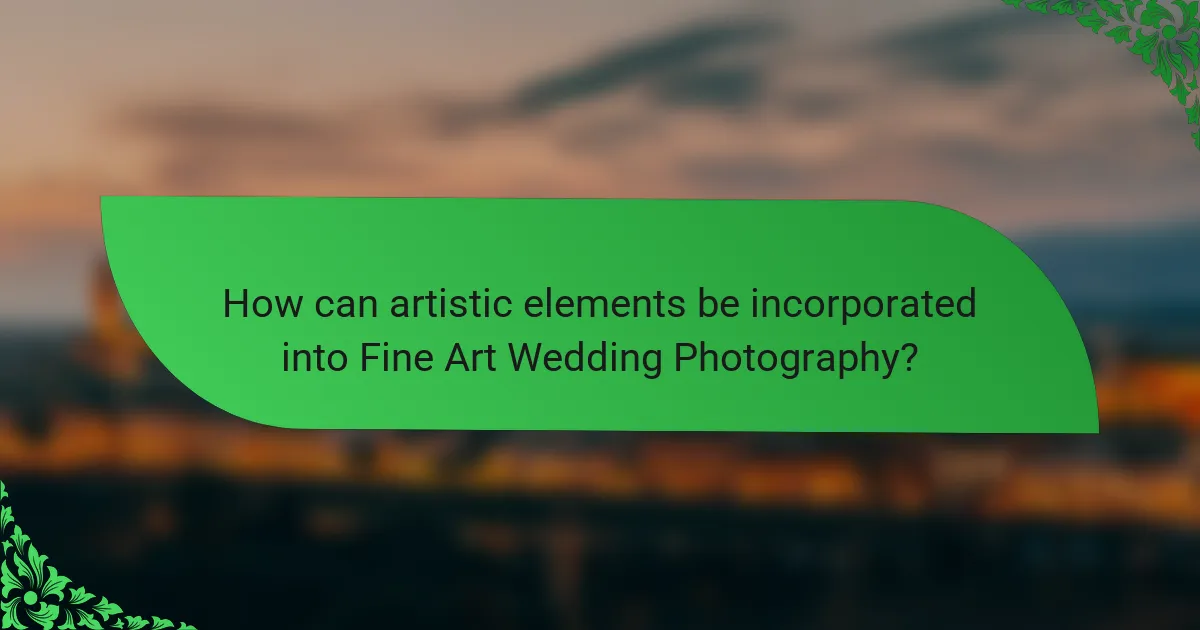
How can artistic elements be incorporated into Fine Art Wedding Photography?
Artistic elements can be incorporated into Fine Art Wedding Photography through various techniques. Utilizing natural light enhances the mood and creates soft, ethereal images. Composing shots with unique angles adds depth and interest to the photographs. Incorporating textures, such as fabrics or natural surroundings, enriches the visual narrative.
Incorporating color palettes that complement the wedding theme creates a cohesive aesthetic. Using negative space emphasizes the subject and creates a more artistic feel. Capturing candid moments adds authenticity and emotion to the storytelling.
Additionally, post-processing techniques can enhance artistic elements, allowing for creative interpretations of the images. These methods collectively contribute to a refined and artistic representation of the wedding day.
What techniques can photographers use to enhance artistic elements?
Photographers can enhance artistic elements through various techniques. Composition techniques like the rule of thirds create balance and focus. Use of leading lines guides the viewer’s eye through the image. Color theory can evoke emotions and set the mood. Natural light enhances textures and creates depth. Experimenting with depth of field isolates subjects and adds interest. Incorporating reflections can introduce unique perspectives. Post-processing techniques can refine images and enhance artistic vision. Each technique contributes to the overall aesthetic and storytelling in photography.
How do color palettes influence the artistic feel of wedding photos?
Color palettes significantly influence the artistic feel of wedding photos. They set the mood and tone of the images. Different colors evoke specific emotions; for example, soft pastels create a romantic atmosphere. In contrast, bold colors can convey vibrancy and energy. The choice of color palette also affects the overall composition and harmony of the photos. Consistent color schemes enhance visual storytelling. Research shows that color psychology plays a crucial role in how viewers perceive images. A well-chosen palette can elevate the artistic quality of wedding photography.
What role does post-processing play in creating artistic elements?
Post-processing plays a crucial role in creating artistic elements in photography. It enhances the visual appeal of images by adjusting colors, contrast, and clarity. Techniques like dodging and burning can emphasize specific areas, guiding the viewer’s attention. Additionally, post-processing allows for the application of creative effects, such as adding grain or softening images. This flexibility enables photographers to express their artistic vision uniquely. Studies show that well-executed post-processing can significantly elevate the perceived quality of photographs. For example, a 2020 survey found that 75% of photographers believe post-processing is essential for achieving their desired aesthetic.
How can couples collaborate with photographers to achieve artistic results?
Couples can collaborate with photographers to achieve artistic results by communicating their vision clearly. They should discuss their preferred styles and themes before the shoot. Sharing inspiration through mood boards or reference images helps align expectations. Couples can also suggest specific locations that hold personal significance. Engaging in a pre-shoot consultation allows for detailed planning. During the shoot, couples should feel comfortable expressing their ideas. Photographers can then adapt their techniques to capture these artistic elements. This collaboration often leads to more authentic and creative images.
What should couples communicate to photographers about their artistic vision?
Couples should communicate their desired aesthetic and emotional tone to photographers. This includes preferences for colors, styles, and specific moods they wish to capture. Couples can discuss inspirations from other photographers or artworks that resonate with them. They should also share any specific moments or details they want highlighted. Additionally, couples should clarify their vision for post-processing techniques, such as light and airy versus dark and moody styles. Clear communication ensures that photographers understand their artistic vision. Research indicates that effective communication enhances satisfaction with wedding photography outcomes.
How can couples provide inspiration for artistic elements in their wedding photos?
Couples can provide inspiration for artistic elements in their wedding photos by sharing their personal stories and preferences. They can discuss their favorite colors, styles, and themes that reflect their relationship. Couples should also consider locations that hold special meaning to them. Unique props and personal items can add depth to the visuals. Collaborating with the photographer on creative ideas enhances the artistic direction. Engaging in mood boards or Pinterest can help visualize concepts. Sharing favorite artworks or photographers can guide the artistic approach. Ultimately, clear communication of their vision fosters a tailored and meaningful photographic experience.
What tips can enhance the incorporation of artistic elements in Fine Art Wedding Photography?
To enhance the incorporation of artistic elements in Fine Art Wedding Photography, focus on composition and lighting. Utilize natural light to create soft, romantic images. Experiment with angles and perspectives to add depth and interest. Incorporate negative space to emphasize the subjects. Use props and backdrops that align with the couple’s story for a personalized touch. Pay attention to color palettes to evoke specific emotions. Capture candid moments to convey genuine emotions and interactions. Lastly, post-processing techniques can enhance artistic qualities, such as using film-like presets or softening sharpness for a dreamy effect.
Fine Art Wedding Photography Styles focus on artistic expression and aesthetic quality, encompassing documentary, portraiture, and editorial approaches. Key characteristics include an emphasis on composition, lighting, and emotional storytelling, resulting in timeless images that reflect the couple’s unique narrative. The article explores the differences between Fine Art and traditional photography styles, the emotional impact on viewers, and how couples can choose and collaborate with photographers to achieve artistic results. Additionally, it discusses the role of lighting, composition, color palettes, and post-processing in enhancing the artistic elements of wedding photography.
